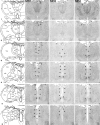Dissociable performance on scene learning and strategy implementation after lesions to magnocellular mediodorsal thalamic nucleus
- PMID: 17978029
- PMCID: PMC2241732
- DOI: 10.1523/JNEUROSCI.1835-07.2007
Dissociable performance on scene learning and strategy implementation after lesions to magnocellular mediodorsal thalamic nucleus
Abstract
Monkeys with aspiration lesions of the magnocellular division of the mediodorsal thalamus (MDmc) are impaired in object-in-place scene learning, object recognition, and stimulus-reward association. These data have been interpreted to mean that projections from MDmc to prefrontal cortex are required to sustain normal prefrontal function in a variety of task settings. In the present study, we investigated the extent to which bilateral neurotoxic lesions of the MDmc impair a preoperatively learnt strategy implementation task that is impaired by a crossed lesion technique that disconnects the frontal cortex in one hemisphere from the contralateral inferotemporal cortex. Postoperative memory impairments were also examined using the object-in-place scene memory task. Monkeys learnt both strategy implementation and scene memory tasks separately to a stable level preoperatively. Bilateral neurotoxic lesions of the MDmc, produced by 10 x 1 microl injections of a mixture of ibotenate and NMDA did not affect performance in the strategy implementation task. However, new learning of object-in-place scene memory was substantially impaired. These results provide new evidence about the role of the magnocellular mediodorsal thalamic nucleus in memory processing, indicating that interconnections with the prefrontal cortex are essential during new learning, but are not required when implementing a preoperatively acquired strategy task. Thus, not all functions of the prefrontal cortex require MDmc input. Instead, the involvement of MDmc in prefrontal function may be limited to situations in which new learning must occur.
Figures





References
-
- Aggleton JP, Brown MW. Episodic memory, amnesia, and the hippocampal-anterior thalamic axis. Behav Brain Sci. 1999;22:425–444. discussion 444–489. - PubMed
-
- Aggleton JP, Mishkin M. Memory impairments following restricted medial thalamic lesions in monkeys. Exp Brain Res. 1983;52:199–209. - PubMed
-
- Browning PG, Easton A, Buckley MJ, Gaffan D. The role of prefrontal cortex in object-in-place learning in monkeys. Eur J Neurosci. 2005;22:3281–3291. - PubMed
Publication types
MeSH terms
Substances
Grants and funding
LinkOut - more resources
Full Text Sources
Molecular Biology Databases
